#High Carbon Stainless Steel Knives
Text
Between 2009 and 2011 no one knew what to get me as a gift for gift giving events such as christmas so everyone just bought me knives/random sharp things. I have so many random knives and swords scattered around my bedroom because I don't know what to do with them
2 tanto (like a straight single-edge dagger)
a "tactical" kukri
1 butterfly knife
1 unsharpened shitty flea market katana (blue)
1 very sharp high carbon steel katana (brown)
1 claymore sword
2? ...3? machetes
a finger ring claw thing with a curved knife coming out of the knuckle
a 3-bladed Wolverine claw lookin Spencer's gift shop skull... thing (very unsafe, very sharp)
I don't even know what the hell else I've got laying around but this definitely isn't all of it. They're just hidden in random places all over my room, I haven't seen some of them in like 5+ years. I don't even have any formal training for how to use any of these
#textpost#The brown katana; the claymore; and the butterfly knife are the only ones I actively maintain/care about tbh#The katana and claymore are the only high carbon steel ones too. The others are all just stainless iirc#(I can't do any tricks with the butterfly knife before anyone asks)#All I know how to do with any of these is swing the claymore hard enough to make it whistle like a baseball bat#The rain of knives ended when I had to start literally begging people to get me anything else haha
23 notes
·
View notes
Note
Hello! I have always been interested in wood carving.. I have some nice pieces of wood I have collected and I would like to know what kind of knife you recommend?
Absolutely! I'll be the first to say you can carve beautiful things with almost ANY SHARP knife. I've used pocket knives to machetes and full on survival knives, so long as it's kept sharp, it will work. Efficiency is the trade off.

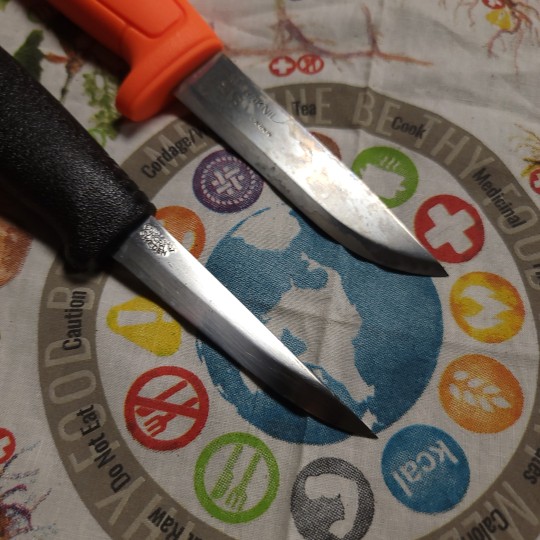
The easiest suggestion is, of course, the venerable Morakniv knives. The orange 511 can routinely be had for less than 10 USD, and you get quite a lot of knife for that money. The finger guard is nice if you have minimal knife experience and are concerned for any possible mishaps. The steel is excellent and either available in stainless steel or carbon steel. Carbon will rust, stainless will not rust as easily. The carbon steel gets a little sharper and stays sharper longer. The knives are scandi-ground which refers to the grind of the blade. Scandi ground blades work wood very well and are easy to sharpen at any skill level. Which is good because you'll need to keep it sharp to prevent accident cuts. Specific carving knives like the other pictured knife are the most efficient for wood working. The blade grind is much finer for detail work and wood removal, but they are typically best suited as just carving knives. They can be more fragile to work with and do not usually feature a finger guard.
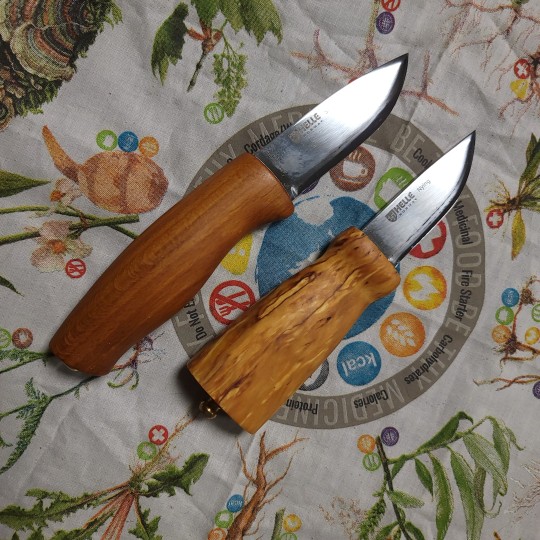
Another, more premium option, is knife makers like Helle or Casstrom. You get a nicer looking knife in this price tag range of around 100~ USD. These will work like the Mora knives but typically can have more premium steel and handle materials. You can also get handmade knives from places like Etsy, local manufacturers and craftsmen, and other online retailers. There is a sea of great knives available out there and the price will only increase from that humble Mora 511.

Of course, the swiss army knife also makes a great whittling knife. However, the fact that the blade can close onto your fingers and cause an injury makes me hesitant to recommend folding knives to anyone looking to start carving. Maybe try it after one has some experience in with other knives first. I like carving with pocket knives, but non locking blade knives come with their own set of precautions.

There is also some other good items to pick up to make life easier, and your carving adventures more enjoyable. Cut resistant gloves and woodcarving wrap help protect your fingers and hand from accident slashes, (a stab will still go through) A small or bench sized whetstone and leather strop are essential to keep your tools nice and sharp for the most pleasant carving experience. YouTube has some great resources on how to sharpen knives. Last item is a fine toothed saw. This is a Silky brand, but any fine tooth saw will work. This is used to trim off your carvings from the host stick and cut wood to the size you want to work with. I prefer the Silky saws for the exchangable blades and high performance they have.
Anyways, I hope this helps get you, (Or anyone!) started with this extremely fun little activity. Feel free to ask anything else you might want to know!
3 notes
·
View notes
Text

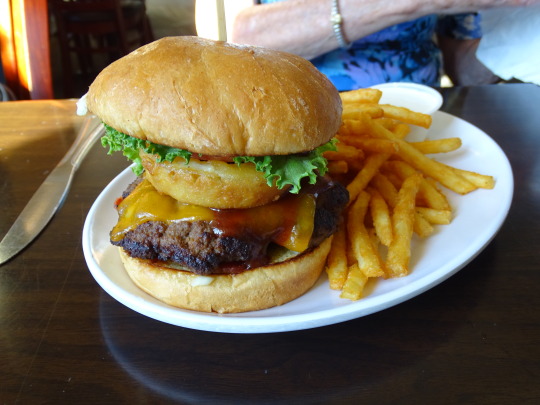






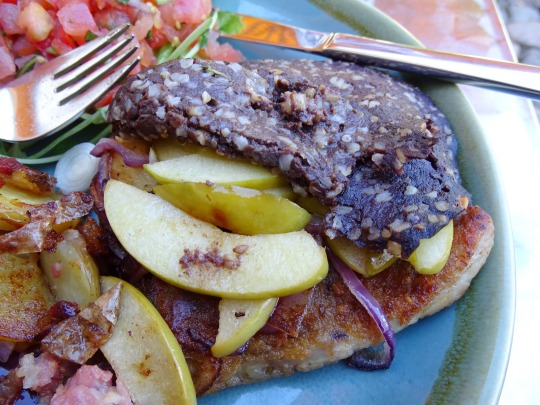
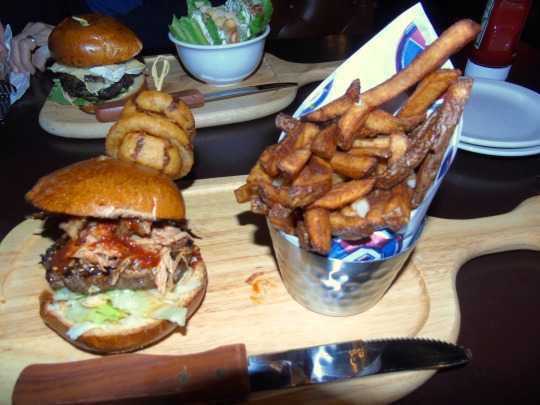

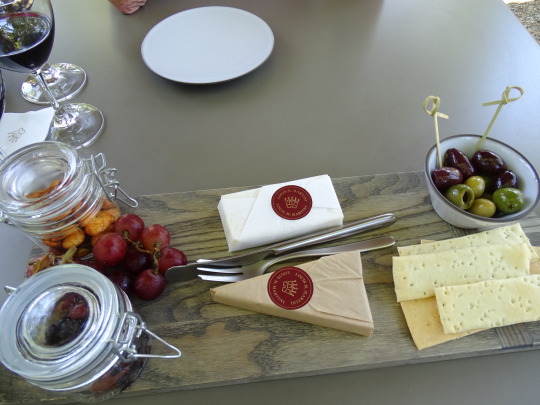
National Knife Day
Grab or pull out your knives! Today we celebrate them, no matter their size, style, or brand! It is unknown who started National Knife Day or when they started it, but it was being celebrated by at least 2011. It is also unknown why the observance takes place on August 24, but one explanation appears to be that the date is connected to the Bowie knife. It was on this date in 1838 that Rezin Bowie, the brother of the knife’s namesake, wrote a letter to the Planters’ Advocate claiming he was the person who had created the knife.
One of the earliest tools known to humankind, the knife was present at the beginnings of the development of human civilization and came out of the need for survival. Early on, knives were used as primitive tools for digging and construction, as weapons, and to hunt, fish, and gather food. In contrast to today, almost everyone carried a knife. The first knives were made of stones which were cracked to make a sharp edge like a blade. Sharpened stone tools became more advanced during the late Lithic periods, and then even more so during the Copper and Bronze Ages. Metal blades appeared, which weren’t as sharp and didn’t stay sharp as long as the stone blades that preceded them. This led to the introduction of sharpening stones.
During the Iron age, tools became stronger and more durable. Iron knives came on the scene and stayed sharper longer. Steel blades followed iron ones, and not much has changed since then. Steel blades, which are made of an alloy of iron that has carbon, are the most common today and are known for being durable and efficient. Cobalt alloys and titanium are also used in knife making today.
Early knives didn’t have a separate handle and blade—they were all one piece. Eventually, handles began being made out of carved bone, wood, and metal, and then, rare materials like mother-of-pearl and tortoiseshell began being used. Today, wood is one of the most popular materials used for knife handles, and metals like stainless steel are also common. One other change besides that advent of a separate handle was the invention of the folding knife.
Knives have many different purposes in the present day, some of which are the same as they have been for thousands of years. Some ways they are used are to prepare food, as a utensil when eating food, by surgeons and medical professionals, to dress an animal, to fillet a fish, and for carving. There are various types of kitchen knives such as the chef’s, utility, paring, and bread knives. Most knives are affordable to just about anyone, but there are high-end custom knives such as Randall Made Knives, most of which sell for $400 of more. In many locations, there are laws that pertain to knives: ownership laws exist for certain types of knives, open and concealed carry laws apply to certain types of knives, and other types of laws exist, such as those that say a robbery is an “aggravated crime” with more severe punishment if a knife is involved. There also are certain areas where some types of knives are not permitted, such as at schools or on planes.
How to Observe
Knives should be used more today than on any other day of the year. Here are a few ideas on how to spend the day:
Do some knife throwing.
Do some whittling.
Prepare some food using a knife or multiple knives. It might be beneficial to first learn what type of knife is appropriate for different types of food.
Get a pocket knife, which has many uses.
Check for knife promotions such as giveaways and sales happening today. This is often a large part of the day.
Give someone a knife as a gift.
Clean, oil, and sharpen your knives.
Carry your knives around in a holster.
Cut a lot of things with your knives, such as food, paper, and rope.
Source
#National Knife Day#USA#Canada#Germany#Schnitzel-Himmel und Erde#food#restaurant#travel#vacation#original photography#Fire Jumper Burger#steak#filet#burger#bread#cookie#NationalKnifeDay#24 August#Jacobs & Co. Steakhouse#Louis M. Martini Winery#St. Francis Winery & Vineyards
2 notes
·
View notes
Text
Selecting the Perfect Hunting Knife: A Comprehensive Guide
A hunting knife is an indispensable tool for outdoor enthusiasts and avid hunters. It serves various purposes, including field dressing game and handling campsite tasks. With a wide array of hunting knives available, choosing the right one can be overwhelming. This blog post provides an in-depth guide to help you make an informed decision by exploring the key factors to consider, such as blade types, handle materials, and other important features.

Blade Types: a. Drop Point: The drop point blade is versatile and suitable for general hunting tasks. It features a curved spine and a durable point, providing excellent control for skinning, slicing, and precise cuts. b. Gut Hook: Designed specifically for field dressing, the gut hook blade has a sharpened hook on the spine. It allows for safe and easy gutting without puncturing the intestines. c. Clip Point: Ideal for detailed tasks like caping, the clip point blade has a concave curve and a sharp point, enabling precise and delicate cuts. d. Skinning Blade: The skinning blade, with its sweeping, curved edge, facilitates efficient hide removal from game animals while minimizing the risk of meat punctures.
Blade Materials: a. Stainless Steel: Stainless steel blades are popular among hunters due to their rust and corrosion resistance, durability, and ease of maintenance. They retain sharpness well. b. High Carbon Steel: High carbon steel blades offer exceptional strength and edge retention, making them suitable for heavy-duty tasks. However, they require regular maintenance to prevent rust. c. Damascus Steel: Damascus steel blades feature beautiful patterns created by layering different steel alloys. They are visually stunning, durable, and sharp.
Handle Materials: a. Wood: Wooden handles provide a traditional and visually appealing look. They offer a comfortable grip but require periodic maintenance to prevent cracking or warping. b. Rubber: Rubber handles provide a secure, non-slip grip, even in wet conditions. They are easy to clean and offer excellent durability and shock absorption. c. G10: Constructed from fiberglass soaked in resin, G10 handles are lightweight, durable, and resistant to moisture and chemicals. They provide a reliable grip in various weather conditions. d. Micarta: Micarta handles are made from layers of resin-soaked linen or paper. They are highly durable, moisture-resistant, and offer a comfortable grip.
Tang Types: a. Full Tang: Full tang knives have blades that extend the entire length of the handle, providing superior strength and balance for heavy-duty tasks. b. Partial Tang: Also known as hidden tang, this design features a blade that does not extend the full length of the handle. Partial tang knives are lighter but may be less robust.
Additional Features: a. Blade Length: Choose a blade length based on your specific needs and preferences. Shorter blades offer maneuverability, while longer blades provide better cutting power. b. Sheath: A quality sheath is essential for safe storage and easy carrying of your hunting knife. Look for a durable, secure sheath that allows for convenient access. c. Blade Edge: Decide between a plain edge or a serrated edge based on your requirements. Plain edges offer precision and ease of sharpening, while serrated edges excel at cutting through tough materials.
Conclusion: Selecting the right hunting knife is crucial for a successful hunting experience. By considering factors such as blade type, materials, handle construction, tang type, and additional features, you can find a hunting knife that suits your needs. Remember to prioritize durability, functionality, and comfort to ensure a reliable tool that will serve you well in the great outdoors. Enjoy your hunting adventures!
2 notes
·
View notes
Note
imarku Japanese Chef Knife Gyutou- Pro Kitchen Knife 8 Inch Chef's Knives High Carbon Stainless Steel Sharp Paring Knife with Ergonomic Handle https://a.co/d/1T8mVtc
Ths is so random
1 note
·
View note
Link
Check out this listing I just added to my Poshmark closet: - Pioneer woman steak knife set..
0 notes
Text
Enhance Your Culinary Experience with Chef Knife for Sale at House of Knives
In the realm of culinary arts, the significance of a chef's knife cannot be overstated. A chef knife is not merely a kitchen tool; it's an extension of the chef's hand, a reliable companion in the creation of culinary masterpieces. If you're on the quest for the perfect chef knife, look no further than House of Knives. With an extensive collection of chef knives for sale, House of Knives stands as a beacon for culinary enthusiasts and professionals alike.
01. Chef Knife for Sale:
A chef knife is the cornerstone of every kitchen, serving as a versatile instrument for slicing, dicing, chopping, and mincing. At House of Knives, you'll find a curated selection of chef knives crafted by renowned artisans and esteemed brands. Whether you're a seasoned chef or an aspiring home cook, there's a perfect chef knife waiting for you.
Why choose a chef knife from House of Knives? Quality and precision are paramount. Each knife undergoes rigorous testing to ensure optimal performance and durability. From high-carbon stainless steel blades to ergonomic handles, every aspect is designed with the utmost attention to detail. With a chef knife from House of Knives, you can elevate your culinary skills to new heights.
But the benefits extend beyond functionality. A chef knife is an investment in your passion for cooking. It's a tool that empowers creativity and inspires culinary exploration. With the right knife in hand, you can tackle any recipe with confidence and finesse. Whether you're preparing a simple weekday meal or a gourmet feast, a chef knife from House of Knives will be your trusted companion in the kitchen.
02. House of Knives:
Founded on a legacy of craftsmanship and expertise, House of Knives has been a revered destination for knife enthusiasts since its inception. With a commitment to quality and customer satisfaction, House of Knives has earned a reputation as a premier retailer of fine cutlery.
What sets House of Knives apart is its dedication to offering a diverse range of products to suit every need and preference. From traditional Japanese knives to modern European designs, there's something for everyone at House of Knives. The knowledgeable staff are always on hand to provide expert advice and guidance, ensuring that you find the perfect knife for your culinary endeavors.
But House of Knives is more than just a retailer; it's a community of passionate food lovers united by a shared appreciation for quality craftsmanship. Through workshops, events, and online resources, House of Knives fosters a culture of learning and exploration, empowering customers to hone their skills and discover new culinary horizons.
In conclusion, if you're in search of a chef knife for sale, look no further than House of Knives. With its unparalleled selection, exceptional quality, and commitment to customer satisfaction, House of Knives is the ultimate destination for culinary enthusiasts. Elevate your cooking experience and unleash your culinary creativity with a chef knife from House of Knives.
0 notes
Text
Swiss Precision: Unveiling the Craftsmanship Behind Victorinox Knives
In the world of cutlery, few names resonate with the same level of trust and quality as Victorinox. Renowned for their iconic Swiss Army Knives, Victorinox has solidified its position as a symbol of precision and durability in the realm of blades. However, beyond the multifunctional allure of their pocket tools lies a vast array of specialized knives, each a testament to the brand's dedication to craftsmanship and innovation.
Founded in 1884 by Karl Elsener in the picturesque town of Ibach-Schwyz, Switzerland, victorinox knives began as a humble cutlery workshop. Elsener's commitment to producing knives of exceptional quality soon garnered attention, and the brand's reputation for excellence began to flourish. However, it was in 1891 that Victorinox truly made its mark on history with the creation of the original Swiss Army Knife—a versatile tool that would become synonymous with the brand and a staple in households, military units, and adventurers' pockets worldwide.
What sets Victorinox knives apart is not just their functionality, but the meticulous attention to detail and the unparalleled craftsmanship that goes into their production. Each knife undergoes a rigorous manufacturing process, combining traditional techniques with modern technology to ensure the highest standards of quality.
One of the hallmarks of Victorinox knives is their blades, which are crafted from high-carbon stainless steel—a material renowned for its strength, sharpness, and resistance to corrosion. Whether it's the precision of a chef's knife, the versatility of a paring knife, or the reliability of a serrated utility blade, Victorinox offers a diverse range of options to suit every culinary need.
Beyond their practical utility, Victorinox knives are also prized for their ergonomic designs, which prioritize comfort and control during use. From the iconic red handles of the Swiss Army Knife to the sleek contours of their professional chef's knives, each handle is meticulously crafted to provide a secure grip and minimize fatigue, even during extended periods of use.
Moreover, Victorinox knives are designed with versatility in mind, catering to both professional chefs and home cooks alike. Whether you're slicing, dicing, mincing, or chopping, there's a Victorinox knife perfectly suited to the task at hand. And with a commitment to innovation, the brand continues to push the boundaries of knife design, introducing new materials, features, and technologies to enhance performance and functionality.
In an era where disposable products dominate the market, Victorinox knives stand as a testament to longevity and sustainability. Built to last a lifetime and backed by a legacy of excellence, these knives are more than just tools—they're companions for life's culinary adventures, trusted allies in the pursuit of culinary perfection.
For more info:-
dick knives
cut resistant gloves
1 note
·
View note
Text
Unsheathing Precision: Kentmaster Butcher Knives
In the intricate world of culinary craftsmanship, where every cut counts, the significance of a reliable butcher knife cannot be overstated. Whether it's tenderizing meat, slicing through bones, or precision cutting, the right tool can make all the difference. Amidst the plethora of options available, Kentmaster emerges as a beacon of quality and precision in the realm of butcher knives.
Crafted with a blend of tradition and innovation, Kentmaster butcher knives embody the essence of superior craftsmanship. Each knife is meticulously designed to meet the exacting standards of professional butchers and chefs, ensuring optimal performance and durability.
One of the hallmarks of Kentmaster butcher knives is their exceptional sharpness. Engineered using state-of-the-art technology and premium-grade materials, these knives boast razor-sharp blades that effortlessly glide through even the toughest cuts of meat. Whether it's beef, pork, poultry, or game, Kentmaster knives deliver precision cuts with unparalleled ease.
Butcher knives from Kentmaster are not just tools; they are precision instruments that empower chefs to unleash their culinary creativity. From classic butcher's knives to specialized boning and filleting knives, the diverse range caters to the unique needs of every culinary professional. Each knife is ergonomically designed for optimal comfort and control, reducing fatigue during prolonged use and enhancing overall efficiency in the kitchen.
In addition to their exceptional performance, Kentmaster butcher knives are also renowned for their durability and longevity. Constructed from high-quality materials such as stainless steel and carbon steel, these knives are built to withstand the rigors of daily use in busy commercial kitchens. With proper care and maintenance, a Kentmaster butcher knife can serve as a trusted companion for years to come, making it a worthwhile investment for any culinary enthusiast.
Furthermore, Kentmaster takes pride in its commitment to sustainability and environmental responsibility. The company implements eco-friendly practices throughout the manufacturing process, minimizing waste and reducing its carbon footprint. By choosing Kentmaster butcher knives, chefs can not only enjoy superior quality and performance but also contribute to a more sustainable future for the planet.
In conclusion, Kentmaster butcher knives stand as a testament to the pursuit of excellence in culinary craftsmanship. With their unmatched sharpness, precision engineering, and commitment to sustainability, these knives embody the perfect blend of tradition and innovation. Whether you're a professional chef or a passionate home cook, investing in a Kentmaster butcher knife is a decision that will elevate your culinary endeavors to new heights of perfection.
For more info :-
butchers knife
0 notes
Text
Elevate Your Culinary Experience: A Comprehensive Guide to Season and Stir's Best Kitchen Knives & Other Products
Welcome to Season and Stir, where culinary excellence meets top-tier kitchen tools. As passionate food enthusiasts ourselves, we understand the pivotal role quality equipment plays in crafting memorable dishes. In this guide, we'll explore Season and Stir's collection of best kitchen knives and other products designed toelevate your cooking experience to new heights Best Kitchen Knives.
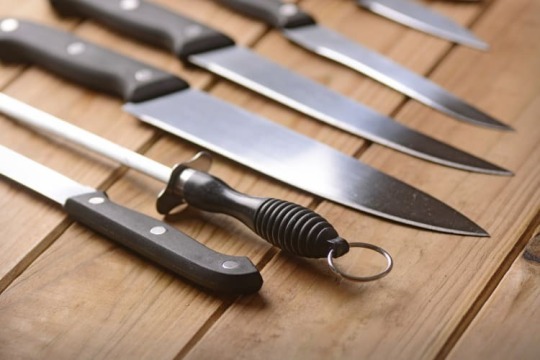
The Art of Knife Mastery
A chef's knife is the cornerstone of any kitchen, and at Season and Stir, we take pride in offering the finest blades crafted with precision and expertise. Here's a breakdown of our best kitchen knives:
1.1. Chef's Knife: Our flagship product, the Chef's Knife, embodies the perfect balance of form and function. Crafted from high-carbon stainless steel, it delivers unparalleled sharpness and durability, making it ideal for chopping, slicing, and dicing with precision.
1.2. Paring Knife: For delicate tasks requiring finesse, look no further than our Paring Knife. Its ergonomic design and razor-sharp blade allow for effortless peeling, trimming, and intricate cutting, ensuring every detail of your culinary creations is perfect.
1.3. Santoku Knife: Inspired by Japanese craftsmanship, our Santoku Knife combines the traditional elegance of Eastern blades with modern innovation. With its versatile blade profile and ergonomic handle, it excels at slicing, dicing, and mincing a wide range of ingredients with ease.
1.4. Bread Knife: Say goodbye to squashed loaves and uneven slices with our precision-engineered Bread Knife. Its serrated edge effortlessly glides through crusty bread, cakes, and pastries, delivering clean, uniform cuts every time.
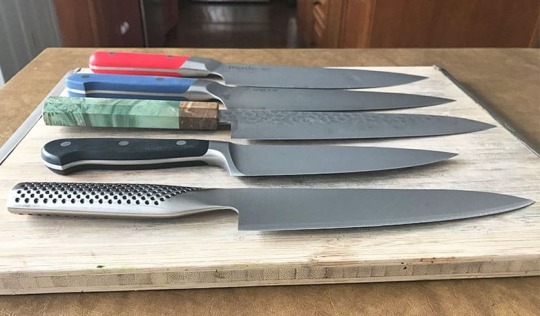
Beyond Knives – Other Essential Products
While knives are essential, Season and Stir also offers a range of other products designed to complement your culinary journey. Here are some highlights:
2.1. Cutting Boards: Our cutting boards are crafted from premium hardwoods such as maple and walnut, providing a durable and hygienic surface for all your chopping needs. Available in various sizes and designs, they add a touch of elegance to any kitchen countertop.
2.2. Knife Sharpeners: Keep your blades razor-sharp with our selection of knife sharpeners. Whether you prefer manual sharpening stones or electric sharpening systems, we have the perfect solution to ensure your knives stay in peak condition for years to come.
2.3. Knife Storage: Protect and organize your knives with our stylish and functional storage solutions. From classic knife blocks to magnetic wall racks, we offer a range of options to suit every kitchen layout and aesthetic preference.
2.4. Kitchen Accessories: Enhance your cooking experience with our assortment of kitchen accessories, including precision scales, herb scissors, and vegetable peelers. Designed with both performance and style in mind, they're the perfect companions for any aspiring chef.

The Season and Stir Difference
At Season and Stir, we're committed to excellence in every aspect of our products and service. Here's what sets us apart:
3.1. Quality Craftsmanship: Each Season and Stir product is crafted with meticulous attention to detail using only the finest materials and manufacturing techniques, ensuring unrivaled quality and performance.
3.2. Customer Satisfaction: We value our customers above all else and are dedicated to providing exceptional service at every step of the purchasing journey. From knowledgeable support staff to hassle-free returns, your satisfaction is our top priority.
3.3. Innovation and Design: We continually strive to push the boundaries of innovation and design, collaborating with industry-leading experts to develop products that not only meet but exceed the evolving needs of modern home cooks.
Whether you're a seasoned chef or a culinary enthusiast just starting your journey, Season and Stir is your trusted partner in the pursuit of culinary excellence. Explore our collection of best kitchen knives and other products today and elevate your cooking experience to new heights. Happy cooking!
0 notes
Text
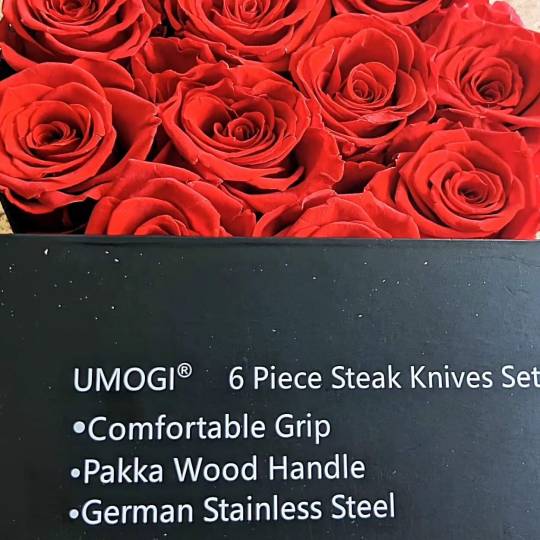
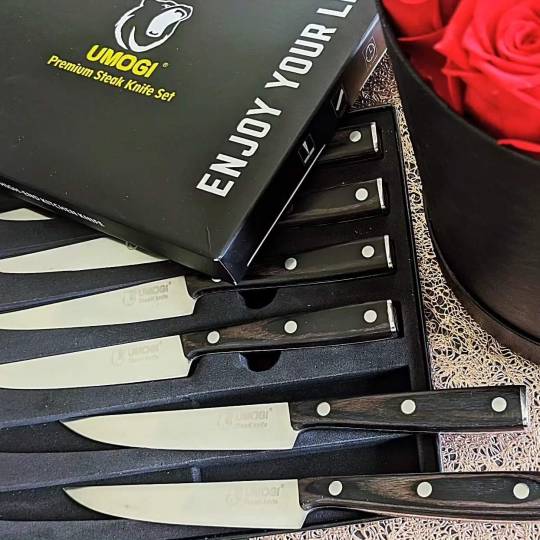



🎁 This high-end steak knives gift set of 6 from the #UMOGI Store on Amazon is awesome! Love the beautiful black natural wooden handles and the blades are made of german stainless steel! The handles of the knives are made of pakkawood so they're anti-corrive and unaffected by heat, cold and moisture making them practical, durable & beautiful! The high-carbon stainless steel blades are incredibly strong and durable too with a handmade fine grinding V edge. Super easy to sharpen and are dishwasher safe!
🎁 This beautiful set of 6 steak knives arrive in a pretty gift box and make a wonderful home warming gift or as a thoughtful gift for just about any occasion. Right now you can get 10% off by clipping the coupon on Amazon -
http://www.amazon.com/gp/product/B094F9DHP1
.
1 note
·
View note
Text
Slice, Dice, and Chop: Mastering the Art of the Kitchen Knife
In the bustling heart of every kitchen, there's one tool that reigns supreme – the kitchen knife. From prepping ingredients to crafting culinary masterpieces, the kitchen knife is the unsung hero that makes it all possible. In this blog post, we'll explore the world of kitchen knives, from their essential features to the different types available, and why they're the indispensable tools every cook needs in their arsenal.
Unveiling the Anatomy of a Kitchen Knife
Before we delve into the intricacies of kitchen knives, let's take a closer look at their fundamental anatomy:
Blade: The blade is the most crucial component of a kitchen knife. It's typically made from stainless steel or high-carbon steel and comes in various lengths and shapes, each suited to different cutting tasks. From the sharp point of a chef's knife to the serrated edge of a bread knife, the blade determines the knife's versatility and effectiveness.
Handle: The handle of a kitchen knife is where comfort and control meet. It's often made from materials like wood, plastic, or metal and is ergonomically designed to fit comfortably in the hand. A well-designed handle provides a secure grip and reduces fatigue during prolonged use, allowing for precise and effortless cutting.
Tang: The tang is the portion of the blade that extends into the handle. A full tang extends the entire length of the handle, providing maximum strength and stability, while a partial tang may extend only partway into the handle. A full tang is generally preferred for its durability and balance, ensuring that the knife feels solid and well-balanced in the hand.
Types of Kitchen Knives
Now that we've covered the basics, let's explore some of the most common types of kitchen knives and their unique characteristics:
Chef's Knife: The workhorse of the kitchen, the chef's knife is a versatile, all-purpose knife with a broad, tapered blade that excels at chopping, slicing, and dicing fruits, vegetables, meats, and herbs.
Paring Knife: The paring knife is a small, versatile knife with a narrow blade that's perfect for precision tasks like peeling, trimming, and intricate cutting work.
Bread Knife: With its serrated edge, the bread knife is designed to slice through bread and other delicate foods with tough exteriors and soft interiors, like tomatoes and cakes, without crushing or tearing.
Utility Knife: The utility knife is a mid-sized knife that bridges the gap between the chef's knife and the paring knife. It's perfect for tasks that require more precision and control than a chef's knife but more cutting power than a paring knife.
Santoku Knife: Originating from Japan, the Santoku knife is similar to a chef's knife but features a flatter blade and a more pronounced tip, making it ideal for slicing, dicing, and mincing vegetables, meats, and fish.
Why Every Cook Needs a Kitchen Knife
Versatility: From chopping and slicing to dicing and mincing, kitchen knives are essential for a wide range of cooking tasks. Whether you're preparing ingredients for a simple weeknight meal or crafting an elaborate dinner party spread, a good set of kitchen knives ensures that you have the right tool for every job.
Precision: A sharp, well-maintained kitchen knife allows for precise, controlled cuts that result in uniform pieces and even cooking. Whether you're julienning vegetables or filleting fish, a sharp knife ensures that your cuts are clean and precise, leading to professional-quality results every time.
Efficiency: A sharp, efficient kitchen knife makes quick work of food prep tasks, reducing the time and effort required to prepare ingredients for cooking. With the right knife in hand, you can breeze through meal prep with ease, allowing you to spend less time in the kitchen and more time enjoying delicious meals with family and friends.
Safety: Contrary to popular belief, a sharp kitchen knife is actually safer to use than a dull one. A sharp knife cuts through food with minimal effort, reducing the risk of slips and accidental cuts that can occur with a dull blade. Additionally, a properly maintained kitchen knife is less likely to slip or twist in your hand, further reducing the risk of accidents.
In conclusion, the kitchen knife is the ultimate tool for any cook, providing versatility, precision, efficiency, and safety in the kitchen. Whether you're a professional chef or a home cook, investing in a good set of kitchen knives is essential for unlocking your culinary potential and creating delicious meals with ease. So sharpen those blades, hone those skills, and get ready to slice, dice, and chop your way to culinary greatness with the timeless art of the kitchen knife.
0 notes
Text
Slice, Dice, and Excel: Navigating the Kitchen with Precision Using the Kitchen Knife
In the bustling hub of culinary creativity, one tool reigns supreme as the cornerstone of kitchen mastery – the kitchen knife. From the simplest of meal preparations to the most intricate culinary creations, the kitchen knife is the trusted companion of every cook, guiding them through the art of slicing, dicing, and chopping with precision and finesse. In this blog post, we'll embark on a journey through the world of kitchen knives, exploring their essential features, versatile uses, and why they're the indispensable tools every kitchen needs.
Unveiling the Essence of the Kitchen Knife
At the heart of every kitchen lies the kitchen knife – a versatile, multifunctional tool that's as essential as it is timeless. Let's uncover the key components that make up the anatomy of a kitchen knife:
Blade: The blade is the backbone of the kitchen knife, crafted from high-quality stainless steel or carbon steel to provide durability and sharpness. It comes in various shapes and sizes, each designed to serve a specific purpose, from the broad, curved blade of a chef's knife to the slender, pointed blade of a paring knife.
Handle: The handle of a kitchen knife is where comfort and control converge, offering a secure grip and ergonomic design that fits comfortably in the hand. It may be crafted from a variety of materials, such as wood, plastic, or composite materials, with a textured surface for added stability during use.
Tang: The tang is the portion of the blade that extends into the handle, providing stability and balance to the knife. A full tang extends the entire length of the handle, while a partial tang may extend only partway into the handle. A full tang is generally preferred for its durability and strength, ensuring that the knife feels solid and well-balanced in the hand.
Versatile Uses of the Kitchen Knife
The kitchen knife is the Swiss Army knife of the culinary world, capable of performing a myriad of tasks with precision and ease. Here are just a few of its versatile uses:
Slicing: Whether you're slicing through fruits, vegetables, meats, or cheeses, the kitchen knife makes quick work of even the toughest ingredients, producing uniform slices with minimal effort.
Dicing: From onions and garlic to potatoes and carrots, the kitchen knife excels at dicing ingredients into precise, uniform pieces, ensuring even cooking and consistent flavor in your dishes.
Chopping: When it comes to chopping herbs, nuts, or vegetables, the kitchen knife is unmatched in its efficiency and precision. Its sharp blade and sturdy construction make quick work of chopping tasks, allowing you to achieve the perfect texture and consistency every time.
Peeling: Whether you're peeling apples for a pie or potatoes for mashed potatoes, the kitchen knife's precise blade makes quick work of removing skins and peels with minimal waste.
Why Every Kitchen Needs a Kitchen Knife
Versatility: With its wide range of uses and applications, the kitchen knife is the ultimate multitasker in the kitchen, capable of handling everything from basic food prep to intricate culinary techniques with ease.
Precision: A sharp, well-maintained kitchen knife allows for precise, controlled cuts that result in uniform pieces and even cooking. Whether you're a professional chef or a home cook, a sharp knife ensures that your cuts are clean and precise, leading to professional-quality results every time.
Efficiency: The kitchen knife is designed for efficiency, allowing you to breeze through food prep tasks with minimal effort and maximum speed. Whether you're cooking for one or preparing a feast for a crowd, a sharp knife helps you get the job done quickly and efficiently, saving you time and energy in the kitchen.
Safety: Contrary to popular belief, a sharp kitchen knife is actually safer to use than a dull one. A sharp knife cuts through food with minimal effort, reducing the risk of slips and accidental cuts that can occur with a dull blade. Additionally, a properly maintained kitchen knife is less likely to slip or twist in your hand, further reducing the risk of accidents.
In conclusion, the kitchen knife is the ultimate tool for culinary excellence, offering versatility, precision, efficiency, and safety in the kitchen. Whether you're a professional chef or a home cook, investing in a high-quality kitchen knife is essential for unlocking your culinary potential and taking your cooking skills to the next level. So sharpen those blades, hone those skills, and get ready to slice, dice, and excel your way to culinary greatness with the timeless art of the kitchen knife.
0 notes
Text
Exploring the Versatility of Mild Steel Round Bars and Comparing them with Other Steel Types and Metals
Introduction:
Steel is a cornerstone material in various industries due to its strength, durability, and versatility. Among the different types of steel, mild steel stands out for its widespread use in construction, manufacturing, and fabrication. In this article, we'll delve into the characteristics of mild steel round bars and compare them with other steel types and metals.
Characteristics of Mild Steel Round Bars:
Mild steel, also known as low-carbon steel, contains a relatively low amount of carbon compared to other types of steel. This results in a material that is ductile, malleable, and easy to work with, making it suitable for a wide range of applications. Mild steel round bars are commonly used for construction purposes, such as in the fabrication of frames, supports, and structural components. They are also utilized in manufacturing machinery, automotive components, and general engineering applications.
Advantages of Mild Steel Round Bars:
Cost-Effective: Mild steel round bars are more affordable compared to other types of steel, making them a cost-effective choice for large-scale projects.
Easy to Fabricate: Due to its low carbon content, mild steel is easy to cut, weld, and shape, allowing for efficient fabrication processes.
Good Ductility: Mild steel exhibits good ductility, meaning it can be stretched or bent without breaking, making it suitable for forming complex shapes.
Versatility: Mild steel round bars are versatile and can be used in various applications across different industries, from construction to manufacturing.
Comparison with Other Steel Types:
Stainless Steel: Unlike mild steel, stainless steel contains chromium, which provides corrosion resistance. While stainless steel is more expensive, it is preferred in applications where corrosion resistance is essential, such as in marine environments or food processing.
Carbon Steel: Carbon steel contains a higher carbon content than mild steel, resulting in increased hardness and strength. Carbon steel is commonly used in applications requiring higher mechanical properties, such as knives, tools, and machinery parts.
Alloy Steel: Alloy steel contains additional alloying elements such as manganese, nickel, or chromium, which enhance specific properties such as strength, hardness, or corrosion resistance. Alloy steel is often used in critical components where superior performance is required, such as aerospace or automotive applications.
Comparison with Other Metals:
Aluminium: Aluminium is lighter and more corrosion-resistant than steel, making it suitable for applications where weight reduction and corrosion resistance are critical, such as in aerospace and automotive industries.
Copper: Copper exhibits excellent electrical conductivity and corrosion resistance, making it ideal for electrical wiring, plumbing, and heat exchangers.
Titanium: Titanium is known for its high strength-to-weight ratio, corrosion resistance, and biocompatibility, making it valuable in aerospace, medical, and chemical processing industries.
Conclusion:
Mild steel round bars offer a balance of strength, ductility, and affordability, making them a popular choice across various industries. While mild steel may not possess the corrosion resistance or high mechanical properties of other steel types or metals, its versatility and cost-effectiveness make it indispensable for many applications. Understanding the characteristics and comparisons of mild steel with other materials enables engineers and manufacturers to make informed decisions when selecting materials for their projects.
0 notes
Link
Check out this listing I just added to my Poshmark closet: - Pioneer woman steak knife set..
0 notes
Text
What Sets Tac Knives Apart: Features and Characteristics!
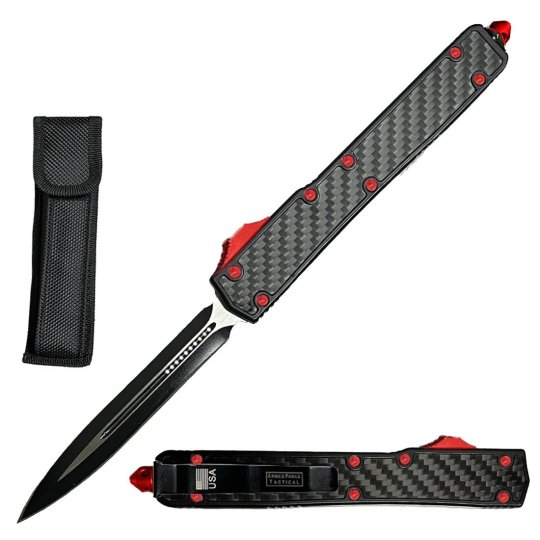
The tactical knife, also known as a tac knife, is a multipurpose and essential tool that is valued by everyone from everyday carriers to military personnel to outdoor enthusiasts. Because of its versatile, long-lasting, and functional design, it can be used for a variety of tasks. These knives are known for their remarkable cutting ability and resilience. They usually have a strong blade made of premium stainless steel or other resilient materials.
Its ergonomic handle is frequently made for a firm grip, guaranteeing accurate control under trying circumstances. Many knives come equipped with extra features like integrated tools like glass breakers and seatbelt cutters for emergencies, thumb studs or flipper mechanisms for quick deployment, and serrations for cutting through tough materials. This knife is a dependable tool that can be used for self-defense, survival, camping, and daily tasks. It can handle any task with ease and accuracy.
Features and Characteristics of Tac Knife:
The majority of tactical knives have several features that increase their usefulness and adaptability. These could include a robust blade made of premium stainless steel or other long-lasting materials that will hold its edge over time and withstand heavy use. Furthermore, a lot of these knives have textured grips and ergonomic handles for a comfortable and secure grip even in challenging circumstances. Additionally, some models might have integrated tools like bottle openers, glass breakers, and seatbelt cutters, which would increase their usefulness in an emergency.
Sturdy Construction:
Tactical knives' sturdy construction is the reason behind their reputation for toughness and longevity. These knives, which are usually made of premium materials like titanium, high-carbon steel, or stainless steel, can bear the strain of hard jobs without losing their quality. To improve hardness and edge retention and ensure longevity even under heavy use, the blades are frequently heat-treated.
Adaptable Blade Designs:
One of the main qualities that distinguishes these knives is their adaptable blade designs. To suit different needs and tastes, these knives are available in tanto, drop point, spear point, and clip point shapes and styles. Furthermore, a lot of knives have partially or fully serrated blades, which adds cutting power for jobs involving difficult materials like fibrous vegetation or rope.
Ergonomic Handles:
Ergonomic handles are a common feature of a tac knife because comfort and control are important when using them. These knives frequently have handles made of G-10, aluminum, or reinforced polymers, which are intended to give the user a firm and comfortable grip even in slick or damp circumstances. Ergonomic contours, finger grooves, and textured patterns improve handling even more and lessen hand fatigue with extended use.
Assisted Opening Mechanisms:
For quick and simple deployment, tactical knives usually include assisted opening mechanisms. Thumb studs, flipper tabs, and assisted springs are examples of mechanisms that enable users to quickly and easily deploy a blade with just one hand. This makes them perfect for everyday tasks that need quick access to a cutting tool or tactical scenarios.
Integrated Tools and Features:
To increase their usefulness and adaptability, tactical knives frequently have integrated tools and features. Glass breakers, seatbelt cutters, hex wrenches, and bottle openers are typical additions that give users multipurpose tools for a range of uses. Tactical knives are extremely useful for emergency responders, survivalists, outdoor enthusiasts, and daily carry due to their integrated features.
From Everyday Tasks to Tactical Operations!
Tactical knives are extremely adaptable instruments that can be used for everything from tactical operations to daily tasks. These knives come in very handy for a variety of cutting and utility tasks in daily life, like opening packages, cutting cords or ropes, and doing do-it-yourself projects around the house. They are easy to carry in pockets, backpacks, or tool belts due to their small size and lightweight construction, which guarantees they will always be available when needed.
Furthermore, because they perform well at jobs like food preparation, wood carving, and shelter construction, these knives are a favorite among outdoor enthusiasts and intrepid travelers for outdoor pursuits like camping, hiking, and fishing. Furthermore, in tactical operations and emergencies, tac knives are indispensable tools for law enforcement, military personnel, and first responders.
Tac knife is a dependable cutting tool for self-defense, rescue missions, and survival scenarios because of their sturdy build, adaptable blade designs, and fast deployment mechanisms. These knives are essential tools that provide versatility, dependability, and peace of mind in a variety of situations, whether it's slicing through seatbelts to free trapped passengers in an automobile accident or breaching doors during a tactical entry.
0 notes